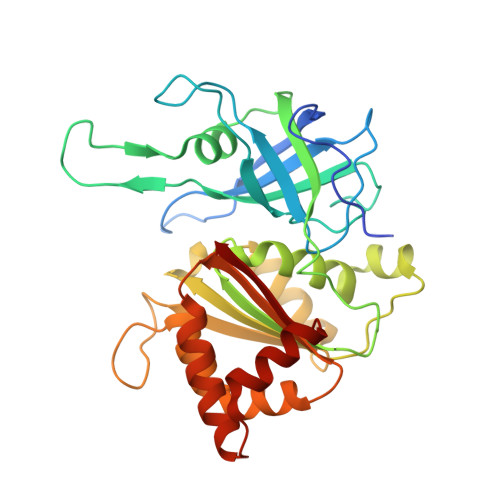External Loops at the Ferredoxin-Nadp(+) Reductase Protein-Partner Binding Cavity Contribute to Substrates Allocation.
Sanchez-Azqueta, A., Martinez-Julvez, M., Hervas, M., Navarro, J.A., Medina, M.(2013) Biochim Biophys Acta 1837: 296
- PubMed: 24321506
- DOI: https://doi.org/10.1016/j.bbabio.2013.11.016
- Primary Citation of Related Structures:
4C43 - PubMed Abstract:
Ferredoxin-NADP(+) reductase (FNR) is the structural prototype of a family of FAD-containing reductases that catalyze electron transfer between low potential proteins and NAD(P)(+)/H, and that display a two-domain arrangement with an open cavity at their interface. The inner part of this cavity accommodates the reacting atoms during catalysis. Loops at its edge are highly conserved among plastidic FNRs, suggesting that they might contribute to both flavin stabilization and competent disposition of substrates. Here we pay attention to two of these loops in Anabaena FNR. The first is a sheet-loop-sheet motif, loop102-114, that allocates the FAD adenosine. It was thought to determine the extended FAD conformation, and, indirectly, to modulate isoalloxazine electronic properties, partners binding, catalytic efficiency and even coenzyme specificity. The second, loop261-269, contains key residues for the allocation of partners and coenzyme, including two glutamates, Glu267 and Glu268, proposed as candidates to facilitate the key displacement of the C-terminal tyrosine (Tyr303) from its stacking against the isoalloxazine ring during the catalytic cycle. Our data indicate that the main function of loop102-114 is to provide the inter-domain cavity with flexibility to accommodate protein partners and to guide the coenzyme to the catalytic site, while the extended conformation of FAD must be induced by other protein determinants. Glu267 and Glu268 appear to assist the conformational changes that occur in the loop261-269 during productive coenzyme binding, but their contribution to Tyr303 displacement is minor than expected. Additionally, loop261-269 appears a determinant to ensure reversibility in photosynthetic FNRs.
Organizational Affiliation:
Departamento de Bioquímica Biología Molecular y Celular, Facultad de Ciencias, Universidad de Zaragoza, Zaragoza, Spain; Institute of Biocomputation Physics of Complex Systems (BIFI)-Joint Unit BIFI-IQFR (CSIC), Universidad de Zaragoza, Zaragoza, Spain.

















